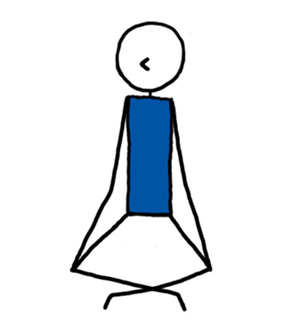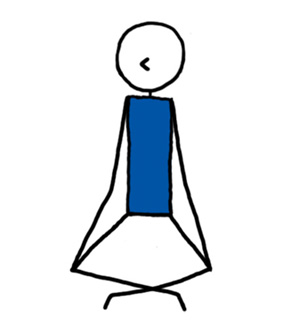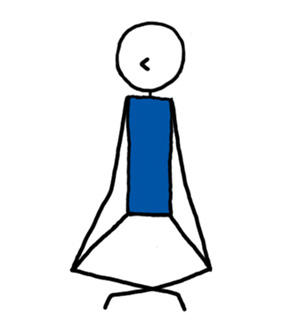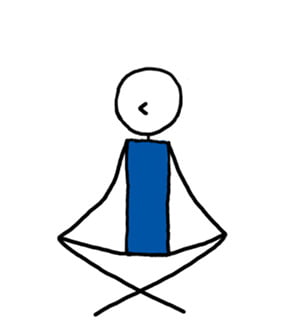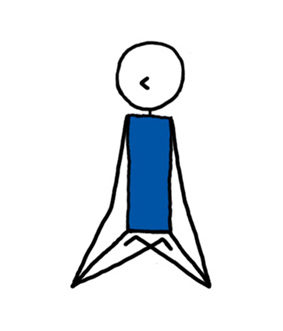
| Category: | Yoga Lesson Planner |
|---|---|
| Sub Category: | Mantras |
| Types: | Seated, Seated & Floor |
| Anatomy: | Core, Hamstrings, Hips, Psoas |
| Chakras: | Base |
| Therapy: | Anxiety, Depression, Eye fatigue, Fatigue, Headaches, Insomnia, Stress |
| Drishti: | Eyebrow |
| Dosha: | Kapha, Pitta, Vata |
| Meridian Lines: | All Meridians |
Sit comfortably with your spine erect. Take a few deep breaths to calm your mind and body. Focus your attention on the base of your spine, and begin to chant the mantra "Lam" aloud or silently. You can repeat the mantra as many times as you feel comfortable for 5 to 15 minutes. As you chant the Lam Mantra, visualize red, glowing energy at the base of your spine.
Deepen your connection to the Muladhara Chakra. Chanting seed mantras can balance and activate the chakras, promote mental clarity, and enhance spiritual growth by connecting with the core vibrational energies of the universe.
A) Sit on a bolster, folded blanket, or block. B) Sit against a wall. C) Sit in a chair. D) Change the cross of the legs. E) Sit in Hero, Perfect or Lotus pose.
Be clear about intention when chanting mantras.
Click here for lots of FREE downloadable Yoga lesson plans.
Click here for lots of FREE downloadable Pilates lesson plans.
- Ask Genie6
- The Root Chakra Sequence
- The Root Chakra Week 2
- Mantras
- Ask Genie6
- Ask Genie3
- mantrasandother
- Pia yin muladhara
- 32 min leg stregth and energy flow part 1
- Ask Genie2
- Ask Genie1
- Ask Genie2
- The Root Chakra Sequence
- The Root Chakra Sequence
- Ask Genie1
- The Root Chakra Sequence 1
- Ask Genie 4
- Ask Genie 7
- Ask Genie 18
How to Teach Lam Mantra
Here’s a bit of background to give to your students about the mantra:
The Lam Mantra is a seed mantra (Bija Mantra) associated with the Muladhara or Root Chakra, the first of the seven major chakras in the human energy system. The Muladhara Chakra is located at the base of the spine, and it is related to our sense of security, stability, and grounding. It is the foundation of the entire chakra system.
The Lam Mantra is used during meditation and yoga practices to help balance, activate, and clear the energy of the Muladhara Chakra. By chanting this mantra, your yoga students can work on strengthening their connection to the earth, their physical body, and their sense of stability and safety in the world. The mantra is said to help eliminate fears, anxiety, and negative emotions related to our survival and basic needs.
The Lam Mantra is often practised alongside other seed mantras corresponding to the other six chakras, as part of a comprehensive chakra balancing and activation practice.
The Lam Mantra is simple to chant and is composed of a single syllable:
“Lam.“
Next up, is the translation.
Lam Translation
“Lam” is a seed mantra and does not have a direct translation in the way that other mantras with words and phrases do. Seed mantras are considered to be the essence or core sound vibrations that represent and resonate with specific energies or aspects of the universe.
The “Lam” seed syllable has a powerful vibrational frequency that resonates with the energy of the Muladhara Chakra.
Lam Pronunciation
The pronunciation of the mantra is:
Lam: “lahm”
“lah” has a short ‘a’ sound, similar to “u” in “but”
“m” is pronounced like the ‘m’ in “mom”
Well done! Keep repeating it over and over again. Imagine you’re the famous singer of Mantras, Diva Premal, and sing the mantra (out loud or silently).
Next up, is how to practice the mantra.
How to Practice Lam Mantra
To practice the Lam Mantra, sit comfortably in a quiet space with your spine erect. Take a few deep breaths to calm your mind and body. Focus your attention on the base of your spine, and begin to chant the mantra “Lam” aloud or silently. You can repeat the mantra as many times as you feel comfortable for 5 to 15 minutes.
As you chant the Lam Mantra, visualize red, glowing energy at the base of your spine. This visualization can help deepen your connection to the Muladhara Chakra and enhance the practice.
Next up, are several free yoga philosophy lesson plans.
Free Yoga Philosophy Lesson Plans
As a yoga teacher, you know that yoga is much more than just a physical practice. It is a holistic approach to health and well-being that includes mental, emotional, and spiritual elements.
One of the fundamental aspects of yoga is its philosophy, which provides a framework for understanding the nature of reality, the human condition, and the purpose of life.
However, teaching yoga philosophy can be challenging, especially if you want to make it engaging and accessible to your students.
In this blog post, I share ten creative yoga philosophy lesson plan ideas (including the Eight Limbs Of Yoga, Purusha, Prakriti, and The Yoga Sutras) that will help you bring this essential aspect of yoga to life in your classes.
Next up, are the benefits of chanting, repeating, or meditating upon a mantra.
10 Benefits of Practising Mantras
Mantras offer various physical, mental, and spiritual benefits, including:
Cultivate Concentration: Chanting mantras can help calm the mind, improve concentration, and sharpen focus, making it easier to stay present during meditation or daily activities.
Stress Reduction: Repeating mantras can help lower stress levels by inducing a relaxed state and calming the nervous system.
Self-awareness: Mantra meditation can promote greater self-awareness and introspection, helping you better understand your thoughts and emotions.
Emotional Healing: Chanting mantras can help release emotional blockages, facilitate emotional healing, and promote inner peace and balance.
Boosted Immune System: The vibrations created by chanting mantras can stimulate the release of hormones that boost the immune system, promoting overall health and well-being.
Increased Energy Levels: Mantra meditation can help balance and energize the body’s chakras, leading to increased vitality and energy levels.
Spiritual Growth: Mantras can help you connect with your inner self, fostering spiritual growth and deepening your spiritual practice.
Improved Communication: Chanting mantras can strengthen the vocal cords and improve speech clarity, making it easier to communicate effectively with others.
Positive Vibrations: Mantras create positive vibrations that can transform negative energy, cleanse the environment, and uplift the mood.
Enhanced Memory: Regular practice of mantra meditation can improve memory, cognitive function, and overall brain health.
Next up, are different ways to sit in Easy Pose (Sukhasana).
Easy Pose (Sukhasana): 6 Modifications
Here are six modifications to make sitting in Easy Pose (Sukhasana) more comfortable:
Modification 1: Sit on a bolster, folded blanket, or block
Elevating the hips can help maintain the natural curve of the lower back, making it easier to sit upright and reducing strain on the hips and knees.
Modification 2: Place a folded blanket or cushion under the knees
If the knees are elevated higher than the hips, supporting them with a blanket or cushion can reduce tension in the hip flexors and groin area.
Modification 3: Adjust foot placement
If crossing the ankles is uncomfortable, try placing one foot in front of the other instead of fully crossing the legs.
Modification 4: Sit against a wall
For additional support and to help maintain proper posture, you can sit with your back against a wall.
Modification 5: Use a chair:
If sitting on the floor is too challenging, you can sit on a chair with your feet flat on the ground and knees bent at a 90-degree angle. Place a cushion or folded blanket on the chair for even more comfort.
Modification 6: Take breaks
If sitting in Easy Pose becomes uncomfortable, take breaks to extend the legs or change the cross of the legs.




 Yoga Lesson Planner
Yoga Lesson Planner
 Pilates Lesson Planner
Pilates Lesson Planner


